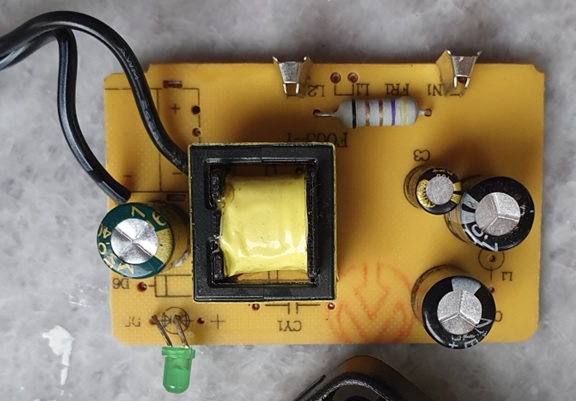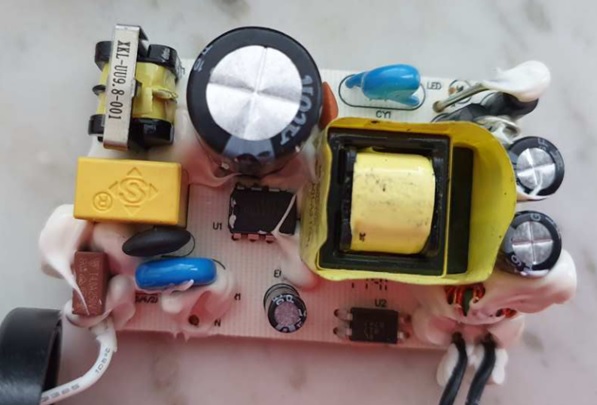6 reasons why you should choose quality power supplies for your devices.
The range of power supplies on the market is very wide, making the choice of a specific version not an easy one, especially when everything important is hidden inside a black plastic case. Below, we offer some considerations on how to choose power supplies, where the savings in low-cost units lie and advice on how to approach the purchase wisely using the example of ESPE power supplies.
1. Safety in use
It is sometimes reported in the media that someone has been fatally electrocuted while using a mobile phone charger in the bathroom. These are extreme cases, as not all incidents make it to the headlines. However, they are a perfect example of how a power supply can prove dangerous to a person. It is undisputed that a good power supply ensures safe use, but what is behind this term? A power supply unit is connected to a mains socket, and the voltage at the output must be galvanically isolated (separated) from the mains. This separation is the responsibility of the insulation in the transformer, which must be thick enough so that it does not break through. This insulation must also be made of durable material so that its protective properties do not deteriorate over time or with increasing temperature. The mains voltage is 230VAC (i.e. 325V at peak), but much greater resistance is required, as surges can always occur. Thunderstorms and lightning discharges can cause a momentary voltage spike well above this value, as can a power disconnection near a transformer or motor. The minimum insulation resistance to overvoltage is assumed to be 1.5 ... 3 kVAC depending on the version, so almost 10 times more. Good power supplies provide even greater resilience and even at higher mains voltages, of the order of 4 kVAC, the insulation does not show a puncture. As a result, even in extreme situations they do not pose a hazard. Such units also generally have double-thickness insulation, so that they do not need to be earthed (they are made in the so-called second protection class). This can be recognised by the fact that they are connected to the mains with a two-wire power cable or have the relevant marking on the label. A safe power supply is also one that has a sealed housing. The lack of holes and the hermetic design with sealed penetrations provide protection against the ingress and condensation of moisture, which is able to significantly deteriorate the insulation and also lead to paralysis.
2. High efficiency
High power conversion efficiency certainly means lower electricity bills, which is increasingly important, but not only that. A high-efficiency power supply heats up little and thus breaks down less often, and is usually smaller and lighter than an equivalent low-efficiency design, as it does not require the use of large heat sinks. High efficiency therefore translates into more mobile and versatile power supplies, greater reliability and a lower price. High-efficiency power supplies are those that meet the requirements of the US DoE Level VI standards and the European CoC 5 regulations. The corresponding symbol on the label (a Roman six in a circle) is confirmation that the unit in question represents the appropriate level here. The required minimum efficiency in these regulations is linked to the output power of the power supply. For example, for a 12V 2A (24W) power supply, this has been specified at 86.2% and for a 50W power supply at 87.8%.
3. Low standby power.
Many electronic devices require power at all times, even though they are not working for a large part of the day. Others, such as phone and laptop chargers, are plugged into a socket permanently and draw power and only operate for a short time. There are more and more such power supplies in our environment, so it is important that the power consumed by them without load is as low as possible. The lower it is, the lower the energy losses are. This is achieved through the sophistication and quality of the electronics design. The better the power supply, the lower the idle (standby) power as a rule. Power supplies up to 50W, meeting the requirements of the American DoE Level VI standards and the European CoC 5 regulations, draw no more than 0.1 watts, those with higher power draw 0.21 watts. But these are maximum values - good units with up to 100W output power do not consume more than 70mW without load, and some are content with as little as 40mW. In the latter case, the annual cost of standby electricity is about 20 cents!
4. Quality of components
A good power supply must be made of high-quality components, because the total good quality of a product is always the resultant value from the parts used. At the top of the list of components are electrolytic capacitors, because they are very sensitive to thermal exposure, have a limited lifespan, degrade quickly when exposed to heat and carry high electrical loads. Most power supply failures are due to their poor quality and short life, so it is important that they are not a coincidence. Electrolytic capacitors have a liquid-soaked paper inside and the heat resulting from high loads or high external temperatures is very damaging to them. When they dry out, the power supply stops working. Hence, reputable manufacturers divide the required capacitance into several smaller ones, so that instead of one capacitor they fit two or three connected in parallel, in order to reduce the unit load and even if one dries out, the others will ensure continued operation. More capacitors unfortunately mean a higher price, but from a quality point of view the price increase is small and the benefit of long operation is very large.
5. Interference.
Cheap power supplies not infrequently cause interference because they do not have effective filters. Interference can be seen on TV screens as a morass, it is inferior mobile phone coverage, buzzing when listening to music, frequent disconnection of Wi-Fi and Bluetooth communication, etc. The reason for these phenomena is inadequate filtering in switched-mode power supplies, which transmits into the mains and reaches sensitive devices in the neighbourhood by radio. A good power supply must have an effective filter on the input consisting of several capacitors and a choke and often has a similar filter on the output. Some still have a ferrite ring mounted on the DC cable to further attenuate unwanted signals. Interestingly, the mains filter also protects the power supply from transients in the mains, such as surges, so its importance for quality is twofold. Extensive filters are costly and heavy, so many low-cost manufacturers keep their size to a minimum. By the way, this also reduces the effectiveness of filtering and surge protection. There are also those who forget about this element, even though its presence is a legal requirement.
6. Safeguards.
A good power supply has effective built-in circuitry to protect it from damage in the event of operating conditions beyond the safe operating range. The occurrence of a current overload at the output or a short circuit, a mains voltage that is too low or too high, may not damage the power supply, but result in a temporary blockage of its operation until the overload subsides. Good power supplies are protected against thermal overload, reverse polarity and also have voltage cut-off circuits should the power supply break down for some reason.
Summary
A high-quality power supply is always the better choice, as a poor one can not only break down quickly, but can also damage the consumer being powered or interfere with other devices in the environment. Many of the criteria related to the quality and safety of power supplies cannot be checked by yourself, i.e. without being a specialist and having a measuring apparatus. Therefore, avoid products behind which reputable manufacturers and commercial brands do not hide.
Photo 1. The interior of a low-cost 12W power supply. The mains filter, output filter, varistor, among others, are missing. There is only one capacitor on the output (left).

Photo 2. The interior of the 12W ESPE high-quality power supply. On the left you can see the mains filter, the protective varistor (blue element), the thermistor (black) and the fuse (brown). On the right, the two capacitors on the output and below them at the DC cable you can see the choke.

